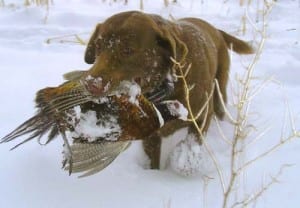December brings holiday cheer, cold weather and the start of two full months of hunting the colorful ring-necked pheasant in northern Oklahoma.
According to biologists with the Wildlife Department, two main factors determine how many pheasants will be available for hunters to pursue each season. The first is the number of adult birds that survive the winter and enter the breeding season.
“The second and most important factor is the number of young birds that survived the summer,” said Doug Schoeling, upland game bird biologist for the Wildlife Department. “What makes or breaks our season on a bird like pheasants – and even other upland birds like quail – is recruitment, or the number of young birds that survive into the fall season. This year, while we have seen a slightly higher survival rate of adult birds, the number of young pheasants produced is down significantly after a season of drought and record high temperatures. With this decrease in production numbers, the 2011 pheasant season harvest is expected to be lower than last year.”
According to Schoeling, there may be exceptions, such as areas with good habitat that received some scattered rainfall. Schoeling said the best way to find those pockets of birds is to go hunting.
The Wildlife Department keeps tabs on the number of adult birds that survived the winter and the number of young pheasants that survived the spring and early summer through two different surveys. First, biologists conduct the annual crow count survey, which provides an idea of how many adult males survived through the winter. In late April and early May, biologists drive county roads and listen for crowing cock pheasants in search of mates. These 20-mile surveys are conducted in Alfalfa, Beaver, Cimarron, Ellis, Garfield, Grant, Harper, Kay, Major, Noble, Texas, Woods, and Woodward counties. Crow counts in recent years show good survival rates of adult birds, with the 2011 counts up five percent from 2010. The population trend has been going up since 2007. In those counties traditionally with the highest pheasant densities (Alfalfa, Beaver, Cimarron, Grant and Texas), and where surveys have been conducted since 1973, crow counts were up 7 percent from last year, with an increasing population trend since 1996.
The survival of young birds over the spring and summer is gauged using annual brood count surveys, which are conducted in late August to provide a measure of how many young pheasants were produced during the nesting season relative to previous years.
“The brood survey is really the primary means we use to determine the annual population status of pheasants and the outlook for the pheasant hunting season,” Schoeling said.
The brood survey is conducted in the same counties as the crow count survey, and observers count the number of pheasants observed and classify the size of young birds to provide an index of pheasant abundance (number seen per mile) and reproductive success. This year, brood survey results were down 40 percent from 2010 due to the unfavorable weather conditions this summer with record heat and drought throughout the pheasant’s range.
Because pheasant hunters only harvest male birds, biologists say hunting pressure has little effect on overall populations and that sportsmen should not hesitate to go hunting.
The ring-necked pheasant was first introduced into Oklahoma in 1911, and the colorful birds prefer cultivated farmland habitat mixed with weedy fencerows and overgrown pastures common across northwestern Oklahoma and the Panhandle.
Pheasant season in Oklahoma runs Dec. 1 through Jan. 31 (only in open areas) and offers hunters a chance at a popular game bird that, though not native to Oklahoma, thrives in the northwestern part of the state.
Hunters should consult the current “Oklahoma Hunting Guide” for open counties and wildlife management areas. The daily bag limit for pheasants is three cocks, with a possession limit of six after the first day and nine after the second day. Evidence of sex (head or one foot) must remain on the bird until it reaches its final destination.
To hunt pheasants, hunters most possess a valid state hunting license, available online at wildlifedepartment.com or at license dealers located across the state. When the deer gun and the holiday antlerless deer seasons overlap with pheasant season, all pheasant hunters must wear either a hunter orange cap or upper garment. For further regulations, including open areas, consult the current “Oklahoma Hunting Guide.”



